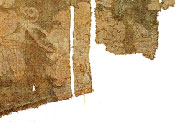 |
 |
|||||||||||||||||||||||||||||||||||||||
 |
||||||||||||||||||||||||||||||||||||||||
 |
||||||||||||||||||||||||||||||||||||||||
| CHAPTER 4 | ||||||||||||||||||||||||||||||||||||||||
 |
||||||||||||||||||||||||||||||||||||||||
| 04.01 Four-petalled floral design 04.01 (late 8th - early 9th century) |
||||||||||||||||||||||||||||||||||||||||
| Ash-resist dyeing on green tabby ground Dimension: warp 40cm; weft 28.5cm China National Silk Museum, Hangzhou (1999.7.2) |
||||||||||||||||||||||||||||||||||||||||
 |
||||||||||||||||||||||||||||||||||||||||
| THE BOOK | ||||||||||||||||||||||||||||||||||||||||
| AUTHOR | ||||||||||||||||||||||||||||||||||||||||
| CONTENTS | ||||||||||||||||||||||||||||||||||||||||
| Small floral patterns were very popular during the Sui to early Tang dynasty. They are widely depicted in wall paintings in Dunhuang and on polychrome figurines found in tombs of this period in the Xi'an region. The floral patterns vary in design: some are roundels with linked pearl borders, some are shaped like the chrysanthemum, and some are rosette. This item has a four-petalled floral design formed by four small flowers in a lozenge shape. The pattern is similar to that on the Tang dynasty textile found on the silk socks from Dulan, Qinghai. There were three common methods of dyeing in Tang dynasty: tie-dyeing, wax-resist dyeing and clamp-resist dyeing. An unusual method was ash-resist dyeing, in which an alkaline compound is applied on the fabric as resist. This is similar to the method of indigo dyeing of present day. In the present item, the resist substance is applied by printing with a small relief block, so that the design areas are sealed off from the dye. After dyeing the fabric green, the resist substance is removed to reveal white designs. The use of the small printing block is evident in the uneven distribution of pattern on this fabric. This method is also used in wax-resist dyeing, and it was recorded in historical texts. Similar designs are widely used on both Tang dynasty woven and printed textiles. Note: Zhao, Lanzhou 1999 |
||||||||||||||||||||||||||||||||||||||||
| ORDER | ||||||||||||||||||||||||||||||||||||||||
| CONTACT | ||||||||||||||||||||||||||||||||||||||||
| LINKS | ||||||||||||||||||||||||||||||||||||||||
|
|
|||||||||||||||||||||||||||||||||||||||